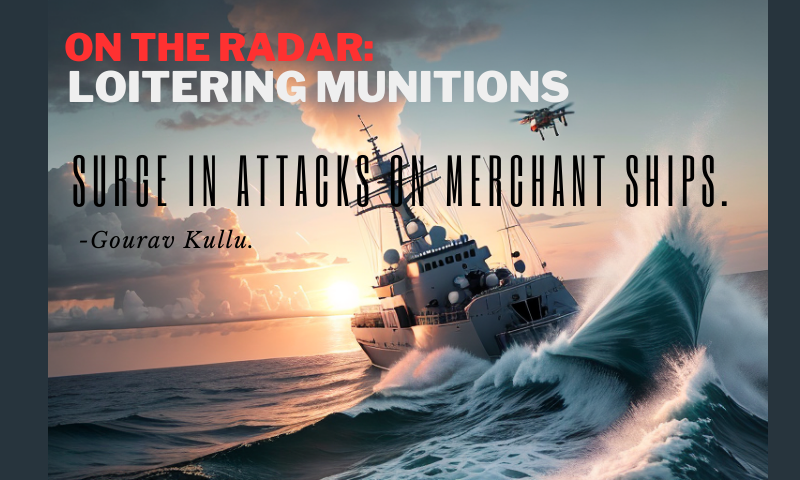On the RADAR: Loitering Munitions and Surge in Attacks on Merchant Vessels.

U.S. Says New Iranian ‘Kamikaze’ Drone Killed Two in Merchant Ship Attack; U.S. Condemn Tehran for Attack (- USNI News, 6 Aug 2021.)
Drone attack on merchant vessel in Arabian Sea. (- India Today, 26 Dec 2023.)
Indian Navy responds after drone attack on merchant vessel carrying 22. (- Indian Express, 18 Jan 2024.)
In recent years, the maritime industry has seen a disturbing increase in attacks on merchant ships, with an alarming trend being the use of Drones and Loitering Munitions as weapons. The gravity of the situation is highlighted by the headlines above. As the frequency of these instances increases, it becomes increasingly important to have a good understanding of Loitering Munitions and the safeguards that a Vessel must take.
This blog is an attempt to explain what Loitering Munitions are. how it works? What precautions do seafarers need to take to avoid such attacks?
What are Loitering Munitions?
Loitering munitions (LM) are unmanned aerial weapons that are intended to hover over a designated region before engaging and striking a target. They are also referred to as "suicide" or "kamikaze" drones. These weapons can be programmed to attack a target after they have been detected, or they can be used to wait passively in a predetermined region until a target is found.
How do they work?
Loitering munitions once launched have the capability to loiter (wait passively) in the target area until the target is located. Loitering munitions can assault targets in a variety of ways, depending on their design and payload. One typical method is a top-down attack, in which the munition approaches the target from above and detonates upon impact. This strategy is frequently used with anti-radiation seekers.
Anti-radiation seekers detect and track the target's radio frequency during the loitering phase and home into their target using a top-down attack.
An LM may be equipped with other sensors such as electro-optical/infrared (EO/IR) sensors, and laser-spot trackers (LST). These sensors help to locate and track its designated target. Additionally, they may be onboarded with a GPS / GLONASS to assist in real-time navigation.
Tracking of the target may be supported by open-source data available on a variety of websites that provide marine tracking services, including detailed histories of ship voyages. Some platforms additionally have 'route forecast' services, which show a ship's expected coordinates during its path. An opponent might potentially use these sources to predict a ship's position.
What precautions can vessels take in response to attacks by loitering munitions?
Considering the nature of the threat various authorities such as INERTANKO, United States Maritime Administration (MARAD), UKMTO, P&I clubs, BIMCO, etc have provided guidelines for merchant vessels transiting the Red Sea. In addition to this, various shipping companies have already considered re-routing their vessels via Cape Town. Below are some precautions in response to attacks by LMs, but not limited to these –
- Risk Assessment – Carry a thorough RA and discuss it with the crew and CSO.
- In general, follow BMP 5. However BMP 5 may be relevant to deter piracy attacks and illegal boardings, but it does not give specific guidance on drone attacks.
- Lookout – Keep an all-round audible and visual lookout.
- Crew training – Brief the crew about the threat posed by the LM and practice emergency drills.
- Muster Point – A safe muster point/citadel must be identified inside the ship and above the waterline.
- Keep LSA / FFA in absolute readiness. Enhancement of medical equipment to deal with multiple casualties.
- Ship reporting – participate in the UKMTO Voluntary reporting scheme and others as advised by the vessel operator.
- AIS management – Only mandatory information is to be fed into the AIS. Although it is believed that a ship’s AIS signals can be the link for the LMs to home in the target, but it is on record that vessels with AIS – switched OFF have also been attacked.
- Evasive manoeuvres – Once an LM is detected vessel should alter course by taking evasive manoeuvres.
The outlined precautions are the foundational framework for safeguarding merchant vessels against rising threats of LMs. It is important to recognize that merchant vessels are designed for cargo transport and are not equipped to counter such sophisticated attacks. Deploying 3D RADAR systems can be expensive for many of the operators today. The shipping industry looks forward to coalition forces and other inter-governmental collaborations to provide safe shipping.
The Silver Lining.
*Image for illustration purposes only.
US Navy ‘kills’ drone with electric-powered laser for first time. (- New York Post 21 Apr 2022.)
Red Sea: UK navy ship HMS Diamond shoots down Houthi drone. (- BBC News, 29 Jan 2024.)
The system employs a combination of RADAR, an electro-optical tracker, and a laser weapon mounted on a naval craft. Once the operator locks on to the drone, the Laser engages, causing structural damage to the drone melting away the plastic and causing the electronics to fail.
In conclusion, it is essential for seafarers to remain vigilant about the growing threat posed by loitering munitions (LM) targeting merchant ships, especially in regions like the Middle East, the Arabian Sea, and the Red Sea. It is crucial to stay informed about the necessary precautions and countermeasures, actively monitoring and implementing regional advisories. Meanwhile, the shipping companies and authorities to collaborate to address the challenges posed by LM drone attacks and enhance the safety and security of merchant vessels. Provide safe passages and boost maritime trade.
References: Loitering Munitions: Threat to merchant ships by OCIMF, Misc. News articles.

Gourav Kullu
With over 21 years of oil tanker experience, I have honed my skills and expertise in navigating the oceans and managing diverse maritime operations.
Experienced marine faculty with 2+ years of teaching expertise in GP Rating, HND Nautical Science, and STCW courses. Committed to creating interactive and practical learning environments for students.
Beyond the waves, I'm a data enthusiast, conducting Power BI courses to bridge the gap between analytics and maritime expertise.
As a driven and dedicated professional, I am equipped with the knowledge, experience, and passion to make a significant impact within the maritime industry.
Leave a comment
View more
Give your career a boost with S&B professional services.
CV Prep/EvaluationMore Jobs
Ship management
Singapore
Operations Manager
Commercial Shipping
Mumbai
Chartering Manager
Ship management
Hazira
Technical Superintendent
Interview Prep/Mentoring
Find your polestar with the host of experts available on our platform
Know more

